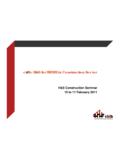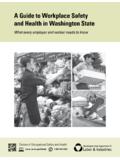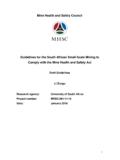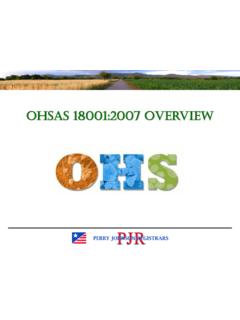Transcription of Water, Sanitation, Hygiene and Health - WHO
1 1 Unit Name water , sanitation , Hygiene and Health Health Security and Environment Doc. Ref: RFP V-1-2011 WHO water Quality Partnership for Health water safety Plans as normal practice: policy and institutional strengthening for WSP mainstreaming Phase 3 Request for Proposals (RFP) Bid Reference 2013/HSE/WSH/0001 2 Unit Name: water , sanitation , Hygiene and Health 2 TABLE OF CONTENTS TABLE OF CONTENTS .. 2 1. INTRODUCTION .. 4 Objective of the RFP .. 4 About WHO .. 4 WHO Mission Statement .. 4 Structure of WHO .. 4 Description of Cluster/Service/Unit .. 5 Definitions, Acronyms and Abbreviations .. 5 2. DESCRIPTION OF SUBJECT / PRESENT ACTIVITIES .. 6 Overview .. 6 3. REQUIREMENTS.
2 7 Introduction .. 7 Characteristics of the provider .. 7 Status .. 7 Accreditations .. 7 Previous experience .. 7 Work to be performed .. 7 4. INSTRUCTIONS TO BIDDERS .. 8 Language of the Proposal and other Documents .. 8 Intention to Bid .. 8 Cost of Proposal .. 8 Contents of the Proposal .. 8 Communications during the RFP Period .. 8 Format and Signing of Proposals .. 9 5) The electronic copies of the proposal and supporting documents on the four (4) CD-ROMs should be in PDF, or MS Word compatible format. The Responses to the Requirements should be submitted according to the format outlined in Proposal Structure Sealing and Marking of Proposals .. 9 Exclusion of Submission of Offers by E-mail .. 10 Period of Validity of Proposals .. 10 Closing Date for Submission of Proposals .. 10 Modification and Withdrawal of Proposals.
3 10 Receipt of Proposals from Non-invitees .. 11 Amendment of the RFP .. 11 Proposal Structure .. 11 Acceptance Form .. 11 Content of proposal .. 11 5. OPENING AND EVALUATION OF PROPOSALS .. 13 Opening of Proposals .. 13 Clarification of Proposals .. 13 Preliminary Examination of Proposals .. 13 Evaluation of Proposals .. 13 Financial Evaluation .. 14 Bidders' Presentations .. 14 6. AWARD OF CONTRACT .. 14 Award Criteria, Award of 14 WHO's Right to modify Scope or Requirements during the Evaluation/Selection Process .. 15 3 Title - Request for Proposal (RFP) WHO's Right to Extend/Revise Scope or Requirements at Time of Award .. 15 WHO's Right to enter into Negotiations .. 15 Signing of the Contract .. 15 7. GENERAL AND CONTRACTUAL CONDITIONS .. 16 Conditions of Contract .. 16 Responsibility .. 16 Source of Instructions.
4 17 Warranties .. 17 Legal Status .. 17 Relation Between the Parties .. 18 No Waiver .. 18 Liability .. 18 Assignment .. 18 Officials not to Benefit .. 18 Indemnification .. 18 Contractor's Responsibility for Employees .. 19 Subcontracting .. 19 Place of Performance .. 19 Language .. 19 Confidentiality .. 19 Title Rights .. 20 Termination and Cancellation .. 20 Force Majeure .. 21 Surviving Provisions .. 21 Use of WHO name and emblem .. 21 Successors and Assignees .. 21 Payment .. 22 Title to Equipment .. 22 Insurance and Liabilities to Third Parties .. 22 Settlement of Disputes .. 23 Observance of Laws .. 23 Authority to 23 Privileges and Immunities .. 23 No Terrorism or Corruption .. 23 8. PERSONNEL .. 24 Approval of Contractor Personnel .. 24 Project 24 Foreign Nationals .. 25 Compliance with WHO s Policies.
5 25 Ethical Behaviour .. 25 Engagement of Third Parties and use of In-house Resources .. 25 9. ANNEX A .. 26 10. ANNEX B .. 28 4 Unit Name: water , sanitation , Hygiene and Health 4 1. INTRODUCTION Objective of the RFP The World Health Organization (WHO)/Australian Agency for International Development (AusAID) water Quality Partnership for Health seeks to build on existing efforts to support the development and implementation of water safety Plans (WSPs). As part of this work, WHO is seeking proposals to support continued scale up and mainstreaming of WSPs in Bangladesh, Bhutan, Lao PDR, Nepal, the Philippines, Vietnam, Cambodia, Indonesia, Mongolia, Myanmar, the Pacific Islands and Timor Leste. It is envisioned that more countries will be included as WHO supports additional countries in WSP implementation and scale up.
6 Through a request for proposal (RFP) process WHO is looking for a consultant to support continued scale up and mainstreaming of WSPs in a number of countries, including as part of the WHO-AusAID water Quality Partnership The project is expected to run over a period of three years. WHO is an Organization that is dependent on the budgetary and extra-budgetary contributions it receives for the implementation of its activities. Bidders are therefore requested to propose the best and most cost-effective solution to meet WHO requirements, while ensuring a high level of service. About WHO WHO Mission Statement WHO was established in 1948 as a specialized agency of the United Nations. The objective of WHO ( ) is the attainment by all peoples of the highest possible level of Health . Health , as defined in the WHO Constitution, is a state of complete physical, mental and social well being and not merely the absence of disease or infirmity.
7 WHO's main function is to act as the directing and coordinating authority on international Health work. Structure of WHO The World Health Assembly (WHA) is the main governing body of WHO. It generally meets in Geneva in May of each year and is composed of delegations representing all 194 Member States. Its main function is to determine the policies of the Organization. In addition to its public Health functions, the Health Assembly appoints the Director-General, supervises the financial policies of the Organization, and reviews and approves the proposed programme budget. It also considers reports of the WHO Executive Board, which it instructs with regard to matters upon which further action, study, investigation or report may be required. The Executive Board is composed of 34 members elected for three-year terms.
8 The main functions of the Board are to give effect to the decisions and policies of the WHA, to advise it and generally to facilitate its work. The Board normally meets twice a year; one meeting is usually in January, and the second is in May, following the World Health Assembly. The WHO Secretariat consists of some 8,300 Health and other officers at the Organization's headquarters in Geneva, in the six regional offices and in countries. The Secretariat is headed by the Director-General, who is appointed by the WHA on the nomination of the Executive 5 Title - Request for Proposal (RFP) Board. The current Director-General is Dr Margaret Chan. The head of each regional office is a Regional Director. Regional directors are appointed by the Executive Board in agreement with the relevant regional committee.
9 Description of Cluster/Service/Unit In the context of WHO Strategic Objective 8, the Department of Public Health and Environment aims to promote a healthier environment, intensify primary prevention and influence public policies in all sectors so as to address the root causes of environmental threats to Health . Guided by World Health Assembly Resolution 64/24 the water , sanitation , Hygiene and Health (WSH) Unit contributes to reducing the burden of disease associated with lack of access, availability and management of water , sanitation and Hygiene . It focuses on: water -borne disease; water , sanitation and Hygiene (WASH)-related Health risks in humanitarian crises,; disease transmission and WASH-related Health risks in the home and in public buildings, including in Health care centres and schools.
10 The Unit focuses on strengthening the evidence base to support policy making and decision-taking, and to develop and maintain normative water quality guidelines ; supports their implementation; monitors progress against international development targets; supports global and regional conventions and policy processes on WASH;, and carries out assessments on disease burden, prevention and control. WSH also supports Member States to meet their obligations under the Human Right to Safe Drinking- water and sanitation . Definitions, Acronyms and Abbreviations WHO: World Health Organization AusAID: Australian Agency for International Development WSH: water , sanitation , Hygiene & Health Unit (WHO) PHE: Department for Public Health and Environment (WHO) WASH: water , sanitation and Hygiene 6 Unit Name: water , sanitation , Hygiene and Health 6 2.
















